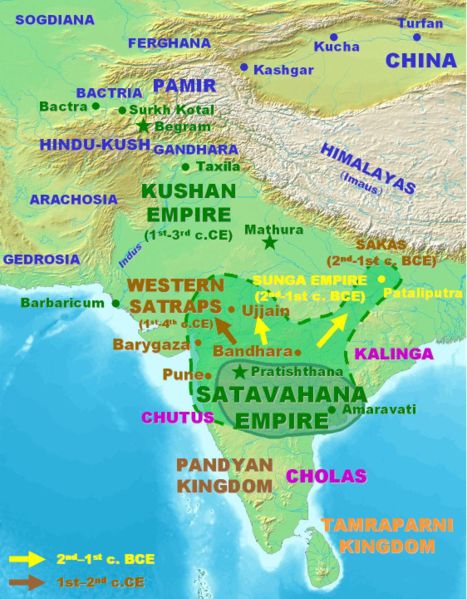Rashtrakuta Dynasty
Rashtrakuta Dynasty
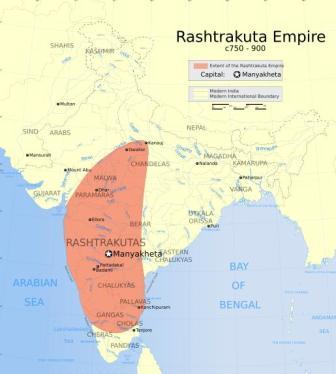 The Rashtrakuta Dynasty was a royal Indian dynasty ruling large parts of southern, central and northern India between the sixth and the thirteenth centuries. During this period they ruled as several closely related, but individual clans. The earliest known Rashtrakuta inscription is a seventh century copper plate grant that mentions their rule from Manpur in the Malwa region of modern Madhya Pradesh. Other ruling Rashtrakuta clans from the same period mentioned in inscriptions were the kings of Achalapur which is modern Elichpur in Maharashtra and the rulers of Kannauj. Several controversies exist regarding the origin of these early Rashtrakutas, their native home and their language.
The Rashtrakuta Dynasty was a royal Indian dynasty ruling large parts of southern, central and northern India between the sixth and the thirteenth centuries. During this period they ruled as several closely related, but individual clans. The earliest known Rashtrakuta inscription is a seventh century copper plate grant that mentions their rule from Manpur in the Malwa region of modern Madhya Pradesh. Other ruling Rashtrakuta clans from the same period mentioned in inscriptions were the kings of Achalapur which is modern Elichpur in Maharashtra and the rulers of Kannauj. Several controversies exist regarding the origin of these early Rashtrakutas, their native home and their language.
The clan that ruled from Elichpur was a feudatory of the Badami Chalukyas and during the rule of Dantidurga, it overthrew Chalukya Kirtivarman II and went on to build an impressive empire with the Gulbarga region in modern Karnataka as its base. This clan came to be known as the Rashtrakutas of Manyakheta, rising to power in South India in 753. At the same time the Pala Dynasty of Bengal and the Prathihara dynasty of Gujarat were gaining force in eastern and northwestern India respectively.
This period, between the eight and the tenth centuries, saw a tripartite struggle for the resources of the rich Gangetic plains, each of these three empires annexing the seat of power at Kannauj for short periods of time. At their peak the Rashtrakutas of Manyakheta ruled a vast empire stretching from the Ganga River and Yamuna River doab in the north to Cape Comorin in the south, a fruitful time of political expansion, architectural achievements and famous literary contributions. The early kings of this dynasty were Hindu but the later kings were strongly influenced by Jainism.
During their rule, Jain mathematicians and scholars contributed important works in Kannada and Sanskrit. Amoghavarsha I was the most famous king of this dynasty and wrote Kavirajamarga, a landmark literary work in the Kannada language. Architecture reached a milestone in the Dravidian style, the finest examples of which are seen in the Kailasanath Temple at Ellora and the sculptures of Elephanta Caves in modern Maharashtra as well as in the Kashivishvanatha temple and the Jain Narayana temple at Pattadakal in modern Karnataka, all of which are UNESCO World Heritage Sites.
Chalukya Dynasty
Chalukya Dynasty
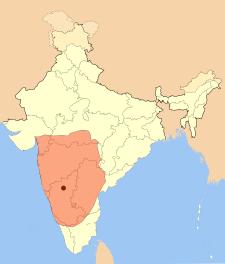 The Chalukya dynasty was an Indian royal dynasty that ruled large parts of southern and central India between the 6th and the 12th centuries. During this period, they ruled as three closely related, but individual dynasties. The earliest dynasty is known as the Badami Chalukyas who ruled from their capital Badami from the middle of the 6th century. The Badami Chalukyas began to assert their independence at the decline of the Kadamba kingdom of Banavasi and rapidly rose to prominence during the reign of Pulakesi II. After the death of Pulakesi II, the Eastern Chalukyas became an independent kingdom in the eastern Deccan. They ruled from the capital Vengi until about the 11th century. In the western Deccan, the rise of the Rashtrakutas in the middle of 8th century eclipsed the Chalukyas of Badami before being revived by their descendants, the Western Chalukyas in late 10th century. These Western Chalukyas ruled from Basavakalyan till the end of the 12th century.
The Chalukya dynasty was an Indian royal dynasty that ruled large parts of southern and central India between the 6th and the 12th centuries. During this period, they ruled as three closely related, but individual dynasties. The earliest dynasty is known as the Badami Chalukyas who ruled from their capital Badami from the middle of the 6th century. The Badami Chalukyas began to assert their independence at the decline of the Kadamba kingdom of Banavasi and rapidly rose to prominence during the reign of Pulakesi II. After the death of Pulakesi II, the Eastern Chalukyas became an independent kingdom in the eastern Deccan. They ruled from the capital Vengi until about the 11th century. In the western Deccan, the rise of the Rashtrakutas in the middle of 8th century eclipsed the Chalukyas of Badami before being revived by their descendants, the Western Chalukyas in late 10th century. These Western Chalukyas ruled from Basavakalyan till the end of the 12th century.
The rise of the Chalukyas marks an important milestone in the history of South India and a golden age in the history of Karnataka. The political atmosphere in South India shifted from smaller kingdoms to large empires with the rise of Badami Chalukyas. For the first time in history, a South Indian kingdom took control and consolidated the entire region between the Kaveri and the Narmada rivers. The rise of this empire also saw the birth of efficient administration, rise in overseas trade and commerce and the development of new style of architecture called Vesara. Around the 9th century, it also saw the growth of Kannada as a language of literature in the Jaina Puranas, Veerashaiva Vachanas and Brahminical traditions. The 11th century saw the birth of Telugu literature under the patronage of the Eastern Chalukyas.
The Chola Empire
The Chola Empire
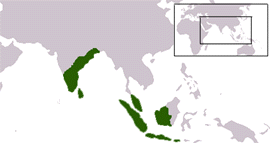 The Chola Dynasty was a Tamil dynasty that ruled primarily in southern India until the 13th century. The dynasty originated in the fertile valley of the Kaveri River. Karikala Chola was the most famous among the early Chola kings, while Rajaraja Chola, Rajendra Chola and Kulothunga Chola I were notable emperors of the medieval Cholas.
The Chola Dynasty was a Tamil dynasty that ruled primarily in southern India until the 13th century. The dynasty originated in the fertile valley of the Kaveri River. Karikala Chola was the most famous among the early Chola kings, while Rajaraja Chola, Rajendra Chola and Kulothunga Chola I were notable emperors of the medieval Cholas.
The Cholas were at the height of their power during the tenth, eleventh and twelfth centuries. Under Rajaraja Chola I (Rajaraja the Great) and his son Rajendra Chola, the dynasty became a military, economic and cultural power in Asia. The Chola territories stretched from the islands of the Maldives in the South to as far North as the banks of the Godavari River in Andhra Pradesh. Rajaraja Chola conquered peninsular South India, annexed parts of Sri Lanka and occupied the islands of the Maldives. Rajendra Chola sent a victorious expedition to North India that touched the river Ganga and defeated the Pala ruler of Pataliputra, Mahipala. He also successfully raided kingdoms of the Malay Archipelago. The power of the Cholas declined around the 12th century with the rise of the Pandyas and the Hoysala, eventually coming to an end towards the end of the 13th century.
The Cholas left behind a lasting legacy. Their patronage of Tamil literature and their zeal in building temples have resulted in some great works of Tamil literature and architecture. The Chola kings were avid builders and envisioned the temples in their kingdoms not only as places of worship but also as centres of economic activity. They pioneered a centralised form of government and established a disciplined bureaucracy
The Pala Empie
The Pala Empie
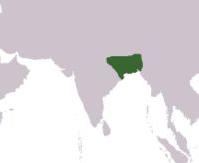 The Pala Dynasty was the ruling Dynasty in Bihar and Bengal India, from the 8th to the 12th century. Called the Palas because all their names ended in Pala, “protector”. The Palas rescued Bengal from the chaos into which it had fallen after the death of Shashanka, a rival of Harsha of Kanauj. The founder of the dynasty was Gopala. Gopala reigned from 750-770 consolidated his position by extending his control over all Bengal. His successor. Dharmapala , 770-781, made the Palas a dominant power of northern India, installing his own nominee on the once-prestigious throne at Kanauj. but the Palas soon were threatened by the Pratiharas of central India and gained respite from attacks only because the of a threat to the Pratiharas from another foreign power, Rashtrakutas of the Deccan.
The Pala Dynasty was the ruling Dynasty in Bihar and Bengal India, from the 8th to the 12th century. Called the Palas because all their names ended in Pala, “protector”. The Palas rescued Bengal from the chaos into which it had fallen after the death of Shashanka, a rival of Harsha of Kanauj. The founder of the dynasty was Gopala. Gopala reigned from 750-770 consolidated his position by extending his control over all Bengal. His successor. Dharmapala , 770-781, made the Palas a dominant power of northern India, installing his own nominee on the once-prestigious throne at Kanauj. but the Palas soon were threatened by the Pratiharas of central India and gained respite from attacks only because the of a threat to the Pratiharas from another foreign power, Rashtrakutas of the Deccan.
Under Devapala, 810-850, the Palas were able to regain their eminence against both the Pratiharas and the Rashtrakutas. Devapala’s successors were peaceful men, either by disposition or circumstance, and after 860 the Pala empire disintegrated. In addition to the depredations of their northern Indian rivals, the Pals also suffered an invasion by the Chola Rajendra I in 1023. Pala fortunes were revived briefly by Rampala 1077-1120, but by the middle of the 12th century the Pala kingdom had succumbed to the rising power of the Senas.
The Palas, adherents to Mahayana Buddhism, were generous patrons of Buddhist temples and the famous universities of Nalanda and Vikramashila. It was through their missionaries that Buddhism was finally established in Tibet. The celebrated Buddhist monk Atisha 981-1054, who reformed Tibetan Buddhism, was the president of the Vikramashila monastery. the Palas also maintained cordial relations with the Hindu-Buddhist state of the Shailendras of Sumatra and Java.
Under Pala patronage a distinctive school of art arose, of which many noteworthy sculptures in stone and metal survive.
THE GUPTA PERIOD
THE GUPTA PERIOD
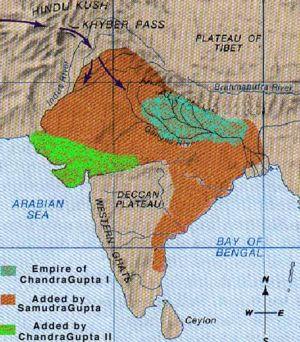 After the downfall of the Kushana empire in about the third century and at the beginning of the 4th century AD, many independent states emerged in North India. One of these states was of the Lichchahavis of Vaisali who dominated portions of North Bengal and South Bihar. This clan obtained possession of Pataliputra, the Capital of the Kushans. Sri Gupta was the first ruler of this dominion. After him his son Ghatokacha ruled with the title of Maharaja. In the fourth century a Lichchavi princess got married to a king in the Magadha who was called Chandragupta I. The reign of Chandragupta I is said to have come to an end in about 330AD. The importance of the rule Chandragupta I centres around the influence of Kumaradevi the Lichchavi princess, coins bearing the figures of the princess speaks of the extent of her influence. Chandragupta became the king of Pataliputra and established a kingdom along the Ganges.
After the downfall of the Kushana empire in about the third century and at the beginning of the 4th century AD, many independent states emerged in North India. One of these states was of the Lichchahavis of Vaisali who dominated portions of North Bengal and South Bihar. This clan obtained possession of Pataliputra, the Capital of the Kushans. Sri Gupta was the first ruler of this dominion. After him his son Ghatokacha ruled with the title of Maharaja. In the fourth century a Lichchavi princess got married to a king in the Magadha who was called Chandragupta I. The reign of Chandragupta I is said to have come to an end in about 330AD. The importance of the rule Chandragupta I centres around the influence of Kumaradevi the Lichchavi princess, coins bearing the figures of the princess speaks of the extent of her influence. Chandragupta became the king of Pataliputra and established a kingdom along the Ganges.
Chandragupta I was succeeded by Samudragupta in about 330AD. He reigned for about fifty yeGoldcoin-Chandragupta I periodars. Inscriptions on a pillar erected by Ashoka gives an account of Samudragupta. After succeeding to the throne of the empire he subdued the powers revolting against his authority in the Gangetic plains and brought their dominions to his kingdoms. He is said to have commanded a military campaign across the Deccan, and also subdued the forest tribes of the Vindhya region. He performed the Ashvamedha sacrifice to establish and proclaim his supremacy. His kingdom also included Lower Bengal, upper Assam and Nepal. Tributes and homage was paid by the rulers and clans including the Malwas, the Yaudheyas, Arjunayansas, the Madras, the Abhiras in Punjab and Rajasthan and others in Madhya Pradesh. Samudragupta led an expedition to the south through the forest tracts of Madhya Pradesh to Orissa, Vishakapatnam, Godavari, Krishna and Nellore district. He is also said to have intruded into Kanchi the capital of the Pallavas.
Samudragupta maintained diplomatic relations with the Kushana King of North west and the ruler of Ceylon. His friendly relation with Ceylon is proved by the fact that King Meghavarna of Ceylon sent an embassy to Samudragupta. With gifts, seeking permission to erect a splendid monastery near the holy tree at Bodh Gaya for the pilgrims from Ceylon. This structure constructed with the permission of Samudragupta was known as Mahabohi Sangharvama. Samudragupta’s personal skill was exceptional especially in music and song. He was also well known for his poetry and had composed many work which had a reputation of a professional author. He was a devotee of Vishnu and thus can be called a Brahmanical Hindu. All these and his role as a monarch qualifies him to be called a hero of hundred battle by a court poet in the Allahabad inscriptions.
Vincent Smith has elevated Samudragupta in Indian history as the Napoleon of India. His tradition of (Milito) religious toleration reflects in the Allahabad inscription and speaks thus ” put to Shama the preceptor of the lord of the gods. Brahaspati by his sharp and polished intellect and Tamburu and Narad by lovely performance.” Samudragupta had several sons. His rule is presumed to have been till about 375AD.
Samudragupta was succeeded by his elder son Ramagupta who was said to have been murdered by Chandragupta II, who did so owing to his brother Ramaguptas uncouth act of surrendering his queen Dhruvadevi to the Saka ruler who subdued him.
Thus Chandragupta ascended the throne of Patilaputra in about 375AD. On assuming the throne of the Gupta empire he took to the title of Vikramaditya. Chandragupta II was a conquerer like his father Samudragupta. His diplomatic tactics in giving his daughter in marriage to Rudrasena II. TheVakattaka king of Deccan helped greatly in securing the vital territory for himself which could prove advantageous in the event of an attack upon the saka satraps of the west from the north. Chandragupta Vikramaditya’s miltary conquests includes the conquest of Malwa, Gujarat and Saurashtra which were under the Saka rule. He defeated Rudrasimha III the last of the western satrap ruler and annexed his territories. This provided exceptional wealth which added to the prosperity of the Guptas. The Guptas at his period had sea trade with the countries of the west. Broach, Sopara, Cambay were ports that facilitated trade. During this period, Ujjain appears to have been the inland centre upon which most of the trade routes converged. Chandragupta occupied the throne for nearly forty years. Pataliputra was a flourishing city. The Gupta administration at this period was mild. Under the Guptas the King assumed a divine character. Chandragupta II was also identified with Vikramaditya of Ujjain. Raja Bikram of popular legend was also a patron of the nine gems including Kalidsa and Varahamihira.
Kumaragupta I was successor of Chandragupta II known as Mahendraditya Kumargupta I, he ruled from 415 AD to 455 AD. He reigned for about 40 years. His empire extended from North Bengal to Kathiawar and from the Himalayas to the Narmada. To the south his kingdom extended as far as the Satara district of the Deccan. He also performed the Ashwameda sacrifice. Towards the end of his rule, the Pushyamitras who were people located near Mekala in the Nerbudda valley became powerful and wealthy. The Pushamitras brought about a temporary eclipse of the Gupta power.This attack on the Guptas were repulsed by Skandagupta who is considered as the last great Gupta ruler. After the succession of Skandagupta he had to subdue the Huns, Skandagupta assumed the title of Vikramaditya. During his campaign against the Huns Skandagupta had to meet great expenses which resulted in the reduction in the issue of gold coins. The Gupta period in Indian history is termed as the Golden Age of India. This period extends from 320 to 480 AD. It extends through the reigns of Chandragupta I, Samudragupta, Chandragupta II, Vikramaditya, Kumaragupta and Skandagupta.The Gupta dynasty continued its existence after the death of Skandagupta. He was succeeded by his son Narasimhagupta followed by Kumaragupta II. Kumaragupta II was followed by Budhagupta. His territory extended from Bengal to central India. The last Gupta ruler was Bhanugupta. During his reign the Hunas wrested Malwas from the Guptas. After his decline in 467Ad the succeeding rulers were weak and could not check the invasion of the Huns and other tribes. After the death of Bhanugupta in 570AD the Gupta empire declined and broke off.
The Gupta period has been described as the golden age of Indian history. It extended from the period of 320AD to 480AD. During this period literature, art and science flourished. Religious toleration and freedom of worship speaks greatly of the Guptas. The great writings of Kalidasa which include Ritusamhara and Meghauta in Sanskrit literature at its highest quality.
The Gupta period is also regarded as a period of Hindu renaissance. Ashoka had succeeded in making Buddhism as the religion as the majority people in Northern India. On doing this neither Brahmanical Hinduism of Jainism died out owing to Ashokas religious toleration propagated by Ashoka. After Ashoka all the rulers that followed showed religious toleration which only added to the prosperity of the territories they ruled. The Guptas though showed a preference to their family deity Vishnu pursued the policy of perfect freedom of worship.
Music, architecture, sculpture and painting was at its best during the period of Gupta rule. The stoner temples of which one at Deogarh in Jhansi, a t Bhitergaon in the kanpur district are few specimens depicting gupta excellence in architecture and sculpture Another area of Gupta excellence was their metallurgical skill. Various copper statues images of Buddha reflects the craftsmanship of the gupta period. The pillar at Delhi made of iron in the time of Samudragupta is also another piece of excellence The Guptas also excellent in the filed of fine arts. All fields of fine arts received royal patronage. Another area of outmost importance during the Gupta reign is the exchange of intellectual ideas which is attributed to the royal patronage and contacts with foreign people of both east and west. Buddhism which was introduced in China from India fostered religious relations promoting constant communication. Chinese missionaries visited India to do reverence to the sacred spots of faith . These visits helped to the sacred spots of faith. These visit helped the Chinese pilgrims knowledge of Sanskrit. Besides China contacts with various islands of South Asia, Indonesia, Persia, Greece and Rome also proves the sound Gupta rule and their diplomatic tactics to provide the best of administration. All these adds to the statement that defines the Gupta period as the Golden age of India.
Kushan Empire
Kushan Empire
In the early 2nd century BC, a tribe on the Central Asian frontier of China called Hsiung-nu defeated a neighboring one known as Yueh-chih. After more conflict, the survivors of the Yueh-chih were dislocated west, passing down the Ili river valley and along the southern shore of lake Issyk Kul. This movement also pushed Saka tribes (and others) ahead of them. Sometime between 145 and 125 BC, these nomad invaders burst into Bactria and Parthia.
A generation later, they were pressing into the Kabul valley and onto the Punjab plain. At around the beginning of the Christian era, one of the five Yueh-chih chiefs, K’iu-tsiu-k’io, attacked and defeated the others, leaving his clan in control; the Kuei-shang (Kushans).
Kujula Kadphises (30-80 AD) established the Kushan dynasty in 78 AD by taking advantage of disunion in existing dynasty of Pahalava (Parthian) and Scytho-Parthians, and gradually wrested control of southern prosperous region, which is the northwest part of ancient India, traditionally known as Gandhara (now Pakistan). It was his grandson Vima Kadphises who made Kushan a paramount power of northern India. His reign saw emergence of Kushan empire when he conquored north-western India (modern Punjab). Soon he came under influence of Hinduism (most likley embraced it for good) and took opportunity to proclaim himself Mahishwara, another name for Lord Shiva, on his coins (Shiva is a prominent Hindu god). Kushan kings introduced gold and copper coins, a large number of them have survived till today. It was the Kushan emperor, Vima Kadaphises who introduced the first gold coins of india. Kushan empire covered north west of India (includes Pakistan and modern Afganistan) and northern India. Ample evidences of trade with China, cental Asia, Egypt and Rome are available which made their economy very strong and kingdom wealthy and prosperous.
Vima’s able son Kanishka (100 – 126 AD) followed and took control of this dynasty in 100 AD. Kanishka is the legendary ruler of ancient India and according to most historians the greatest ruler of Kushan dynasty. He and his descendents called themselves `Devputra’ which means son of god, who ruled Aryavarta, the India. He established an era, commonly known as Shaka era, starts from 78 AD. Shaka era is still in use in India. Kanishka’s empire consisted Bactria (modern Afghanistan), part of central Asia (Tajikistan), north-western India (modern Pakistan) and Northern India till Pataliputra or Patana. Kushan empire.
Huvishka succeeded Kanishka I. He was founder of a city Hushka in Kashmir named after him (described by Kalhan in Rajatarangini). Kushana empire was at its zenith during Kanishka’s and Huvishka’s reign. After Huvishka’s reign, Vasudeva I took control of this dynasty which by then had lost control over regions beyond Bactria or perhaps the Bactria itself. The Kushan dynasty had been totally assimilated in Indian culture. Vasudeva I was the last great king of the dynasty when Kushana empire was at it’s height of splendor and prosperity.
Kushan empire had started its decline soon after Vasudeva’s death. Vasudeva was followed by his son (?) Kanishka II who lost all the territories west of river Indus to Sassanians. Vasudeva II, Vashishka, and Shaka are the kings who followed after the Kanisha II. After Vashishka the Kushan empire had completly disintegrated into few small kingdoms. By fourth century AD this dynasty went into total obscurity with advent of mighty Gupta emperors.
Satavahana Empire
Satavahana Empire
The Satavahanas were also called Andhras. The Aitareya Brahmana claims the Andhras as, the exiled and degenerate sons of Viswamitra. Ashoka inscriptions mentions the Andhras as border people. They were Dravidian people who lived between the Godavari and the Krishna. Simuka was the founder of the Satavahana dynasty. He was succeeded by his brother Krishna.
Scholars are of the opinion that the original home of the Andhras – Andhra bhrityas was the Bellary district. Others claim their recordsto be found in the Northern Deccan and central India. Satakarni was the successor after Simuka, and is a considerable figure, known for his performance of two aswamedha sacrifices. His reign was followed by the rule of Gautamiputra satakarni. He is said to have defeated the Yavanas, Sakas and Phalanas and re-established the ancient glory of the Satavahanas. Gautamiputra satkarni was succeeded by his son Vasisthiputra Sri Pulamavi in about 130 AD. He extended his rule towards the Andhra country. Yajna Sri Satakarni was the last great ruler of the Satavahanas. After him the weak successors resulted in the contraction of the territory of the Satavahanas. Hostility with the Saka rulers also led to the ultimate parceling of its territories and decleration of independence .
The Satavahana society reflected the existence of four classes. The persons who controlled and administered the districts, followed by the officials. They were followed by the Vaidhya, cultivators. The fourth class were common citizen. The head of the family was the Grihapati.
Both Buddhism and Brahmanism was practiced during the Satavahana rule. A state of religions tolerance existed among of various sects of people following varied faiths.
Trade flourished and there existed organisation of workers doing various trades. Broach, Sopara and Kalyan were important trade points. The Satavahana rulers patronised Prakrit which was the common language used on documents.
The Satavahana empire is said to be partitioned into five provinces. The western territory of Nasik was possessed by the Abhiras. The Ikshavakus dominated over the eastern part in the Krishna -Guntur region.
The Chutus possessed the southwestern parts extended their territory to the north and east. The south eastern parts were under the Pahalvas.
The Hathigumpha inscription at Udayagiri near Cuttack speaks of a remarkable rule of a contemporary of the Sungas known as Kharavela of Kalinga. He ruled from about 176Bc to 164 BC. He is said to be the third ruler of the Cheta dynasty.
In the first year of his rule he is said to be have furnished and improved his capital Kalinga. In the second year he subdued and destroyed the capital of the Mushikas disregarding the rule of Satakarni.
In his eighth year he destroyed the fortification of Gordha and entered as far as Rajagriha in the Gaya district. He also conquered king Brihaspatimittra of the Magadha. He also built the Udayagiri and Khandagiri caves to provide shelter to the Jain.
It can be concluded that he was as accomplished ruler and a generous guardian of the people
The Maurya Empire
The Mauryan empire in Indian history was reigned by the rulers from the Mauryan dynasty. According to the ancient history of India, the Mauryan empire happened to be quite strong and powerful in all respect including the political aspects and military aspects. The Mauryan empire had a duration of one hundred and thirty seven years from 322 BCE to 185 BCE.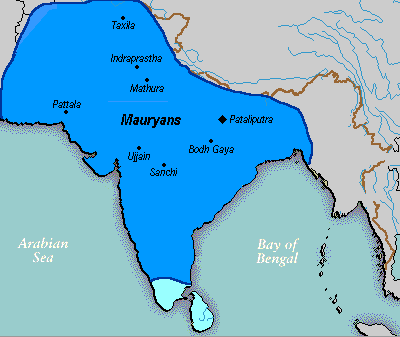
The Mauryan empire in Indian history originated from the Magadha Kingdom that is located on the Indo- Gangetic plains. These are now form the major part of the states of West Bengal and Bihar. The capital city was at Patyliputra which is now near to where Patna is located. Chandragupta Maurya, Bindusara and Ashoka the Great were the remarkable rulers from the Maurya dynasty.
Chandragupta Maurya was admirably successful to establish a strongly centralized state. The administrations was quite complex in comparison to those that prevailed in the states of India in the earlier times. According to Megasthenes, one of the renowned visitors and travelers to the country of India, Patuliputra, the capital city of the Mauryan Empire in Indian history, was walled up by wooden walls with as many as 570 towers and 64 gates.
Bindusara, the successor of Chandragupta Maurya, expanded the area of the state that he inherited from Chandragupta Maurya who reigned for a fairly long period of 24 years. The main targets of Bindusara were the regions in the southern parts of India. Because of the scarcity of informations about Bindusara from the ancient Indian history, little is known about this ruler from the Maurya dynasty. Bindusara’s mother was Durdhara. According to the informations in Puranas the duration of the reign of Bindusara was for a period of 25 years, almost same as his father.
Ashoka was the next emperor after the demise of Bindusara. Ashoka was also known as Ashokabardhan Maurya. But in all the times, even till the present time, he is known as Ashoka the Great. H. G. Wells is of the opinion that Ashoka is the greatest among all of the kings not only in the history of India, but also in the history of the world. Ashoka would have remained the Ashokabardhan for the whole of his life if he would not have come to the noble realization that he had when he visited the battlefield where the Kalinga war was fought. Ashoka invaded Kalinga and became victorious claiming the lives of at least 100000 soldiers and civilians. Nearly ten thousand soldiers who were fighting for Ashoka, also lost their lives. Ashoka was overwhelmingly pained at the loss of so many lives.
The impact of this negative war affair was a tremendously positive one. Ashoka changed his mind and came to the resolution that he would not ever wage any war in future. The reality showed Ashoka to be even more generous. He started spreading the message of peace and non- violence. He not only kept himself stuck to the teachings of Gautama Buddha, but also spread Buddha’s messages to the neighboring countries.
Magadha Empire
Magadha Empire
Amongst the sixteen Mahajanapadas, the kingdom of Magadha rose to prominence under a number of dynasties that peaked in power under the reign of Asoka Maurya, one of India’s most legendary and famous emperors. The kingdom of Magadha had emerged as a major power following the subjugation of two neighbouring kingdoms, and possessed an unparalleled military.
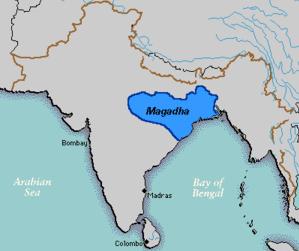
Haryanka dynasty
According to tradition, the Haryanka dynasty founded the Magadha Empire in 684 BC, whose capital was Rajagriha, later Pataliputra, near the present day Patna. This dynasty was succeeded by the Shishunaga dynasty.
Shishunaga dynasty
This period saw the development of two of India’s major religions. Gautama Buddha in the 6th or 5th century BC was the founder of Buddhism, which later spread to East Asia and South-East Asia, while Mahavira founded Jainism. This dynasty lasted till 424 BC, when it was overthrown by the Nanda dynasty.
Nanda dynasty
The Nanda dynasty was established by an illegitimate son of the king Mahanandin of the previous Shishunaga dynasty. Mahapadma Nanda died at the age of 88, ruling the bulk of this 100-year dynasty. The Nandas were followed by the Maurya dynasty. It is said that rumors of the huge size of the Nanda army was in part responsible for the retreat of Alexander from India.
Maurya dynasty
In 321 BC, exiled general Chandragupta Maurya, under direct patronage of the genius of Chanakya, founded the Maurya dynasty after overthrowing the reigning king Dhana Nanda to establish the Maurya Empire. During that time, most of the subcontinent was united under a single government for the first time. Capitalising on the destabilization of northern India by the Persian and Greek incursions, the Mauryan empire under Chandragupta would not only conquer most of the Indian subcontinent, but also push its boundaries into Persia and Central Asia, conquering the Gandhara region. Chandragupta Maurya was influenced by the jainacharya Bhadrabahu and he adopted Jainism.He is credited for the spread of Jainism in southern Indian region. Chandragupta was succeeded by his son Bindusara, who expanded the kingdom over most of present day India, barring Kalinga, and the extreme south and east, which may have held tributary status. Modern day India is an image of the Mauryana, that tied all the peoples and cultures of the erstwhile separate kingdoms under one banner, and predicted a common destiny for all Indians (then mainly Hindus and Buddhists). The tradition was continued later by the Mughals and the British, who formed similar empires.
Bindusara’s kingdom was inherited by his son Ashoka The Great who initially sought to expand his kingdom. In the aftermath of the carnage caused in the invasion of Kalinga, he renounced bloodshed and pursued a policy of non-violence or ahimsa after converting to Buddhism. The Edicts of Ashoka are the oldest preserved historical documents of India, and from Ashoka’s time, approximate dating of dynasties becomes possible. The Mauryan dynasty under Ashoka was responsible for the proliferation of Buddhist ideals across the whole of East Asia and South-East Asia, fundamentally altering the history and development of Asia as a whole. Ashoka the Great has been described as one of the greatest rulers the world has seen. Ashoka’s grandson Samprati adopted Jainism.He was influenced by the teachings of a great jain acharya Arya Suhasti. Following the lines of Ashoka, Samprati spread Jainism in many parts of this world and Indian sub-continent.It is said that Samprati built 1,25,000 Jain Temples all over India, many of which are worshipped today as well.
Sunga dynasty
The Sunga dynasty was established in 185 BC, about fifty years after Ashoka’s death, when the king Brihadratha, the last of the Mauryan rulers, was brutally murdered by the then commander-in-chief of the Mauryan armed forces, Pusyamitra Sunga, while he was taking the Guard of Honour of his forces. Pusyamitra Sunga then ascended the throne.
Kanva dynasty
The Kanva dynasty replaced the Sunga dynasty, and ruled in the eastern part of India from 71 BC to 26 BC. The last ruler of the Sunga dynasty was overthrown by Vasudeva of the Kanva dynasty in 75 BC. The Kanva ruler allowed the kings of the Sunga dynasty to continue to rule in obscurity in a corner of their former dominions. Magadha was ruled by four Kanva rulers. In 30 BC, the southern power swept away both the Kanvas and Sungas and the province of Eastern Malwa was absorbed within the dominions of the conqueror. Following the collapse of the Kanva dynasty, the Satavahana dynasty of the Andhra kindgom replaced the Magandhan kingdom as the most powerful Indian state.
Mahajanpadas
Mahajanpadas
During the life time of Lord Gautam Buddha, sixteen great powers (Mahajanpadas/Mahajanapadas) existed in the 7th and early 6th centuries BC. Among the more important republics were the Sakyas of Kapilavastu and the Licchavis of Vaishali. Besides the republics, there were monarchical states, among which the important ones were Kaushambi (Vatsa), Magadha, Kosala and Avanti. These states were ruled by vigorous personalities who had embarked upon the policies of aggrandisement and absorption of neighbouring states. However, there were distinct signs of the republican states while those under the monarchs were expanding.
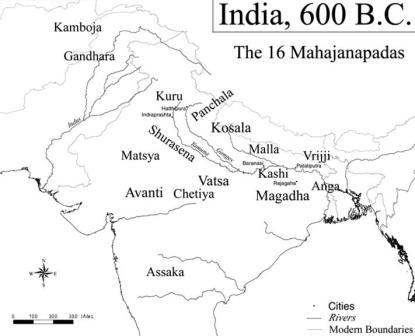
The political structure of the ancient Indo-Aryans appears to have started with semi-nomadic tribal units called “Jana”. Early Vedic texts attest several Janas or tribes of the Aryans, living in semi-nomadic tribal state, fighting among themselves and with other Non-Aryan tribes for cows, sheep and green pastures. These early Vedic Janas later coalesced into Janapadas of the Epic Age.
The term “Janapada” literally means the foothold of a tribe. The fact that Janapada is derived from Jana points to an early stage of land-taking by the Jana tribe for a settled way of life. This process of first settlement on land had completed its final stage prior to the times of Buddha and Panini. The Pre-Buddhist North-west region of Indian sub-continent was divided into several Janapadas demarcated from each other by boundaries. In Panini, Janapada stands for country and Janapadin for its citizenry. These Janapadas were named after the tribes or the Janas who had settled in them. By circa 600 BCE, many of these Janapadas had further evolved into larger political entities by the process of land-grabbing which eventually led to the formation of kingdoms known in Buddhist traditions as the Mahajanapadas or the great nations (Sanskrit: Maha = great, Janapada = country).
The Buddhist and other texts only incidentally refer to sixteen great nations (Solasa Mahajanapadas) which were in existence before the time of Buddha. They do not give any connected history except in the case of Magadha. The Buddhist Anguttara Nikaya, at several places, gives a list of sixteen nations:
1. Kasi 2. Kosala 3. Anga 4. Magadha 5. Vajji (or Vriji) 6. Malla 7. Chedi 8. Vatsa (or Vamsa) 9. Kuru 10. Panchala 11. Machcha (or Matsya) 12. Surasena 13. Assaka 14. Avanti 15. Gandhara 16. Kamboja
The Jaina Bhagvati Sutra gives slightly different list of sixteen Mahajanapadas viz: Anga, Banga (Vanga), Magadha, Malaya, Malavaka, Accha, Vaccha, Kochcha (Kachcha?), Padha, Ladha (Lata), Bajji (Vajji), Moli (Malla), Kasi, Kosala, Avaha and Sambhuttara. Obviously, the author of Bhagvati has a focus on the countries of Madhydesa and of far east and south only. He omits the nations from Uttarapatha like the Kamboja and Gandhara. The more extended horizon of the Bhagvati and the omission of all countries from Uttarapatha clearly shows that the Bhagvati list is of later origin and therefore less reliable (Political History of Ancient India, 1996, p 86; History & Culture of Indian People, Age of Imperial Unity, p 15-16).
The main idea in the minds of those who drew up the Janapada lists was basically more tribal than geographical, since the lists include names of the people and not the countries. As the Buddhist and Jaina texts only casually refer to the Mahajanapadas with no details on history, the following few isolated facts, at best, are gleaned from them and other ancient texts about these ancient nations.
-
Recent
-
Links
-
Archives
- September 2009 (14)
-
Categories
-
RSS
Entries RSS
Comments RSS
